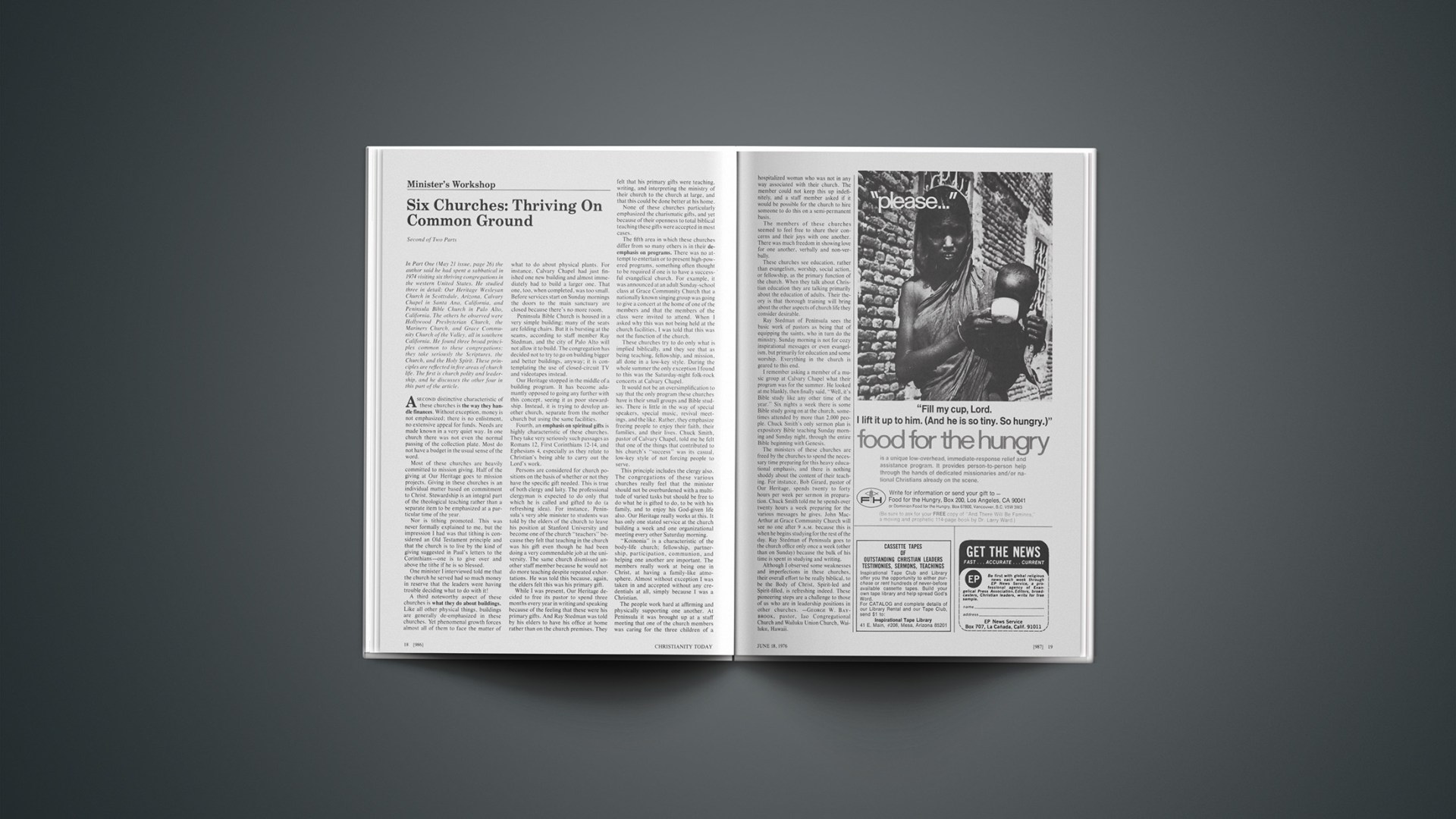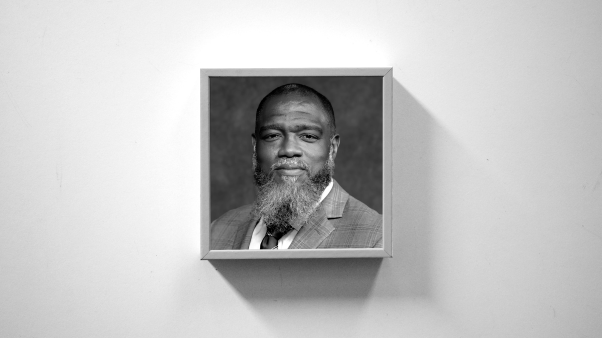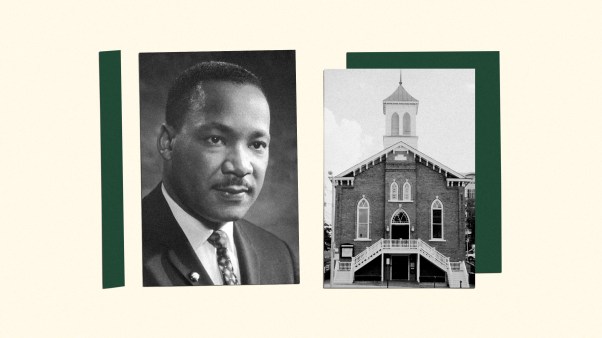In Part One (May 21 issue, page 26) the author said he had spent a sabbatical in 1974 visiting six thriving congregations in the western United States. He studied three in detail: Our Heritage Wesleyan Church in Scottsdale, Arizona, Calvary Chapel in Santa Ana, California, and Peninsula Bible Church in Palo Alto, California. The others he observed were Hollywood Presbyterian Church, the Mariners Church, and Grace Community Church of the Valley, all in southern California. He found three broad principles common to these congregations: they take seriously the Scriptures, the Church, and the Holy Spirit. These principles are reflected in five areas of church life. The first is church polity and leadership, and he discusses the other four in this part of the article.
A second distinctive characteristic of these churches is the way they handle finances. Without exception, money is not emphasized; there is no enlistment, no extensive appeal for funds. Needs are made known in a very quiet way. In one church there was not even the normal passing of the collection plate. Most do not have a budget in the usual sense of the word.
Most of these churches are heavily committed to mission giving. Half of the giving at Our Heritage goes to mission projects. Giving in these churches is an individual matter based on commitment to Christ. Stewardship is an integral part of the theological teaching rather than a separate item to be emphasized at a particular time of the year.
Nor is tithing promoted. This was never formally explained to me, but the impression I had was that tithing is considered an Old Testament principle and that the church is to live by the kind of giving suggested in Paul’s letters to the Corinthians—one is to give over and above the tithe if he is so blessed.
One minister I interviewed told me that the church he served had so much money in reserve that the leaders were having trouble deciding what to do with it!
A third noteworthy aspect of these churches is what they do about buildings. Like all other physical things, buildings are generally de-emphasized in these churches. Yet phenomenal growth forces almost all of them to face the matter of what to do about physical plants. For instance, Calvary Chapel had just finished one new building and almost immediately had to build a larger one. That one, too, when completed, was too small. Before services start on Sunday mornings the doors to the main sanctuary are closed because there’s no more room.
Peninsula Bible Church is housed in a very simple building; many of the seats are folding chairs. But it is bursting at the seams, according to staff member Ray Stedman, and the city of Palo Alto will not allow it to build. The congregation has decided not to try to go on building bigger and better buildings, anyway; it is contemplating the use of closed-circuit TV and videotapes instead.
Our Heritage stopped in the middle of a building program. It has become adamantly opposed to going any further with this concept, seeing it as poor stewardship. Instead, it is trying to develop another church, separate from the mother church but using the same facilities.
Fourth, an emphasis on spiritual gifts is highly characteristic of these churches. They take very seriously such passages as Romans 12, First Corinthians 12–14, and Ephesians 4, especially as they relate to Christian’s being able to carry out the Lord’s work.
Persons are considered for church positions on the basis of whether or not they have the specific gift needed. This is true of both clergy and laity. The professional clergyman is expected to do only that which he is called and gifted to do (a refreshing idea). For instance, Peninsula’s very able minister to students was told by the elders of the church to leave his position at Stanford University and become one of the church “teachers” because they felt that teaching in the church was his gift even though he had been doing a very commendable job at the university. The same church dismissed another staff member because he would not do more teaching despite repeated exhortations. He was told this because, again, the elders felt this was his primary gift.
While I was present, Our Heritage decided to free its pastor to spend three months every year in writing and speaking because of the feeling that these were his primary gifts. And Ray Stedman was told by his elders to have his office at home rather than on the church premises. They felt that his primary gifts were teaching, writing, and interpreting the ministry of their church to the church at large, and that this could be done better at his home.
None of these churches particularly emphasized the charismatic gifts, and yet because of their openness to total biblical teaching these gifts were accepted in most cases.
The fifth area in which these churches differ from so many others is in their de-emphasis on programs. There was no attempt to entertain or to present high-powered programs, something often thought to be required if one is to have a successful evangelical church. For example, it was announced at an adult Sunday-school class at Grace Community Church that a nationally known singing group was going to give a concert at the home of one of the members and that the members of the class were invited to attend. When I asked why this was not being held at the church facilities, I was told that this was not the function of the church.
These churches try to do only what is implied biblically, and they see that as being teaching, fellowship, and mission, all done in a low-key style. During the whole summer the only exception I found to this was the Saturday-night folk-rock concerts at Calvary Chapel.
It would not be an oversimplification to say that the only program these churches have is their small groups and Bible studies. There is little in the way of special speakers, special music, revival meetings, and the like. Rather, they emphasize freeing people to enjoy their faith, their families, and their lives. Chuck Smith, pastor of Calvary Chapel, told me he felt that one of the things that contributed to his church’s “success” was its casual, low-key style of not forcing people to serve.
This principle includes the clergy also. The congregations of these various churches really feel that the minister should not be overburdened with a multitude of varied tasks but should be free to do what he is gifted to do, to be with his family, and to enjoy his God-given life also. Our Heritage really works at this. It has only one stated service at the church building a week and one organizational meeting every other Saturday morning.
“Koinonia” is a characteristic of the body-life church; fellowship, partnership, participation, communion, and helping one another are important. The members really work at being one in Christ, at having a family-like atmosphere. Almost without exception I was taken in and accepted without any credentials at all, simply because I was a Christian.
The people work hard at affirming and physically supporting one another. At Peninsula it was brought up at a staff meeting that one of the church members was caring for the three children of a hospitalized woman who was not in any way associated with their church. The member could not keep this up indefinitely, and a staff member asked if it would be possible for the church to hire someone to do this on a semi-permanent basis.
The members of these churches seemed to feel free to share their concerns and their joys with one another. There was much freedom in showing love for one another, verbally and non-verbally.
These churches see education, rather than evangelism, worship, social action, or fellowship, as the primary function of the church. When they talk about Christian education they are talking primarily about the education of adults. Their theory is that thorough training will bring about the other aspects of church life they consider desirable.
Ray Stedman of Peninsula sees the basic work of pastors as being that of equipping the saints, who in turn do the ministry. Sunday morning is not for cozy inspirational messages or even evangelism, but primarily for education and some worship. Everything in the church is geared to this end.
I remember asking a member of a music group at Calvary Chapel what their program was for the summer. He looked at me blankly, then finally said, “Well, it’s Bible study like any other time of the year.” Six nights a week there is some Bible study going on at the church, sometimes attended by more than 2,000 people. Chuck Smith’s only sermon plan is expository Bible teaching Sunday morning and Sunday night, through the entire Bible beginning with Genesis.
The ministers of these churches are freed by the churches to spend the necessary time preparing for this heavy educational emphasis, and there is nothing shoddy about the content of their teaching. For instance, Bob Girard, pastor of Our Heritage, spends twenty to forty hours per week per sermon in preparation. Chuck Smith told me he spends over twenty hours a week preparing for the various messages he gives. John MacArthur at Grace Community Church will see no one after 9 A.M. because this is when he begins studying for the rest of the day. Ray Stedman of Peninsula goes to the church office only once a week (other than on Sunday) because the bulk of his time is spent in studying and writing.
Although I observed some weaknesses and imperfections in these churches, their overall effort to be really biblical, to be the Body of Christ. Spirit-led and Spirit-filled, is refreshing indeed. These pioneering steps are a challenge to those of us who are in leadership positions in other churches.—GEORGE W. BAYBROOK, pastor, Iao Congregational Church and Wailuku Union Church, Wailuku, Hawaii.










